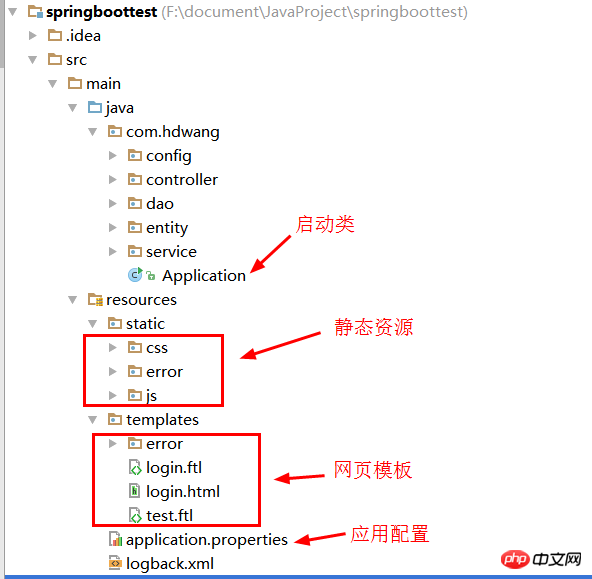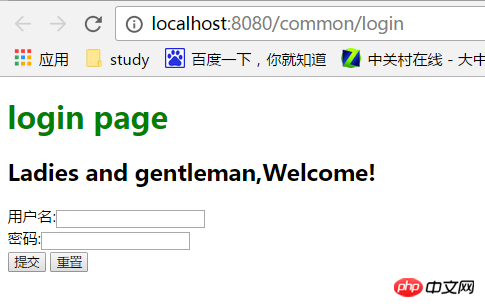Maison >Java >javaDidacticiel >Explication détaillée de l'introduction de Spring Boot à JAVA (web+freemarker)
Explication détaillée de l'introduction de Spring Boot à JAVA (web+freemarker)
- 怪我咯original
- 2017-06-30 10:49:481224parcourir
Cet article présente principalement les informations pertinentes pour démarrer avec Spring Boot (web+freemarker) Les amis qui en ont besoin peuvent s'y référer
1 Configurez le fichier maven pom.xml
<?xml version="1.0" encoding="UTF-8"?>
<project xmlns="http://maven.apache.org/POM/4.0.0"
xmlns:xsi="http://www.w3.org/2001/XMLSchema-instance"
xsi:schemaLocation="http://maven.apache.org/POM/4.0.0 http://maven.apache.org/xsd/maven-4.0.0.xsd">
<modelVersion>4.0.0</modelVersion>
<groupId>com.hdwang</groupId>
<artifactId>spring-boot-test</artifactId>
<version>1.0-SNAPSHOT</version>
<name>spring-boot-test</name>
<description>project for test Spring Boot</description>
<properties>
<project.build.sourceEncoding>UTF-8</project.build.sourceEncoding>
<java.version>1.8</java.version>
</properties>
<!-- Inherit defaults from Spring Boot -->
<parent>
<groupId>org.springframework.boot</groupId>
<artifactId>spring-boot-starter-parent</artifactId>
<version>1.5.4.RELEASE</version>
<relativePath/>
</parent>
<dependencies>
<!-- Add typical dependencies for a web application -->
<dependency>
<groupId>org.springframework.boot</groupId>
<artifactId>spring-boot-starter-web</artifactId>
</dependency>
<dependency>
<groupId>org.springframework.boot</groupId>
<artifactId>spring-boot-starter-freemarker</artifactId>
</dependency>
<!-- auto redeploy -->
<dependency>
<groupId>org.springframework.boot</groupId>
<artifactId>spring-boot-devtools</artifactId>
<optional>true</optional>
</dependency>
<!-- Package as an executable jar -->
<build>
<plugins>
<plugin>
<groupId>org.springframework.boot</groupId>
<artifactId>spring-boot-maven-plugin</artifactId>
</plugin>
</plugins>
</build>
</project>
@SpringBootApplication
public class Application {
/**
* main function
* @param args params
*/
public static void main(String[] args){
SpringApplication.run(Application.class,args);
}
} 4. Créez un contrôleur (dans le répertoire inférieur de la classe Application) @Controller
@RequestMapping("/common")
public class Common {
@Value("${msg:Welcome!}")
private String msg;
/**
* get a page
* @return a page with name called return value
*/
@RequestMapping("login")
public String getLoginPage(ModelMap map){
map.put("welcomeMsg",this.msg);
return "login";
}
}5. un modèle de page Web login.ftl (Freemarker doit utiliser le suffixe ftl, et cela fait longtemps que je me laisse berner ! js/css et ainsi de suite sont placés dans les dossiers correspondants. Notez que /static n'est pas inclus dans l'accès chemin. J'ai aussi été dupé par ça depuis longtemps !) <!DOCTYPE html>
<html>
<head>
<meta charset="UTF-8" />
<title>login</title>
<link href="/css/home.css" rel="external nofollow" rel="stylesheet" type="text/css" />
<script type="text/javascript" src="/js/jquery-2.0.3.min.js"></script>
<script type="text/javascript" src="/js/home.js"></script>
</head>
<body>
<h1>login page</h1>
<h2>${welcomeMsg}</h2>
<form>
<p>
<label>用户名:<input type="text" id="username"/></label>
</p>
<p>
<label>密码:<input type="password"/></label>
</p>
<p>
<input type="submit" value="提交"/>
<input type="reset" value="重置" />
</p>
</form>
</body>
</html>6. Appliquez le fichier de configuration écrivez
créez un nouveau fichier application.properties. et ajoutez le contenu suivantmsg=Ladies and gentleman,Welcome!7. Démarrez et exécutez le navigateur Visitez : http://localhost:8080/common/login

Ce qui précède est le contenu détaillé de. pour plus d'informations, suivez d'autres articles connexes sur le site Web de PHP en chinois!
Déclaration:
Le contenu de cet article est volontairement contribué par les internautes et les droits d'auteur appartiennent à l'auteur original. Ce site n'assume aucune responsabilité légale correspondante. Si vous trouvez un contenu suspecté de plagiat ou de contrefaçon, veuillez contacter admin@php.cn

